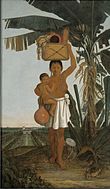
Back Tupí (volk) Afrikaans توبي (شعب) Arabic Тупі Byelorussian Тупи Bulgarian Toupinambaeg Breton Tupís Catalan Tupi (Volk) German Tupioj Esperanto Pueblos tupíes Spanish توپیها Persian
This article needs additional citations for verification. (November 2010) |
  Albert Eckhout's painting of the Tupi | |
| Total population | |
|---|---|
| 1,000,000 (historically), Potiguara 10,837, Tupinambá de Olivença 3,000, Tupiniquim 2,630, others extinct as tribes but blood ancestors to Pardo Brazilian population | |
| Regions with significant populations | |
| Central and Coastal Brazil | |
| Languages | |
| Tupi languages, later língua geral, much later Portuguese | |
| Religion | |
| Indigenous, later Christianity | |
| Related ethnic groups | |
| Guaraní tribes |
The Tupi people, a subdivision of the Tupi-Guarani linguistic families, were one of the largest groups of indigenous peoples in Brazil before its colonization. Scholars believe that while they first settled in the Amazon rainforest, from about 2,900 years ago the Tupi started to migrate southward and gradually occupied the Atlantic coast of Southeast Brazil.[1]
Many Tupi people today are merged with the Guaraní people, forming the Tupi–Guarani languages. Guarani languages are linguistically different from the Tupian languages.[2]
- ^ "Saída dos tupi-guaranis da Amazônia pode ter ocorrido há 2.900 anos" [The departure of the Tupi-Guaranis from the Amazon may have occurred 2,900 years ago]. portalsorocabano.com.br (in Brazilian Portuguese). 2008-12-30. Archived from the original on 2011-10-07.
- ^ LaRosa, Michael; Mejia, German R. (2019). An Atlas and Survey of Latin American History (2nd ed.). United Kingdom: Taylor & Francis. ISBN 9781138089068.